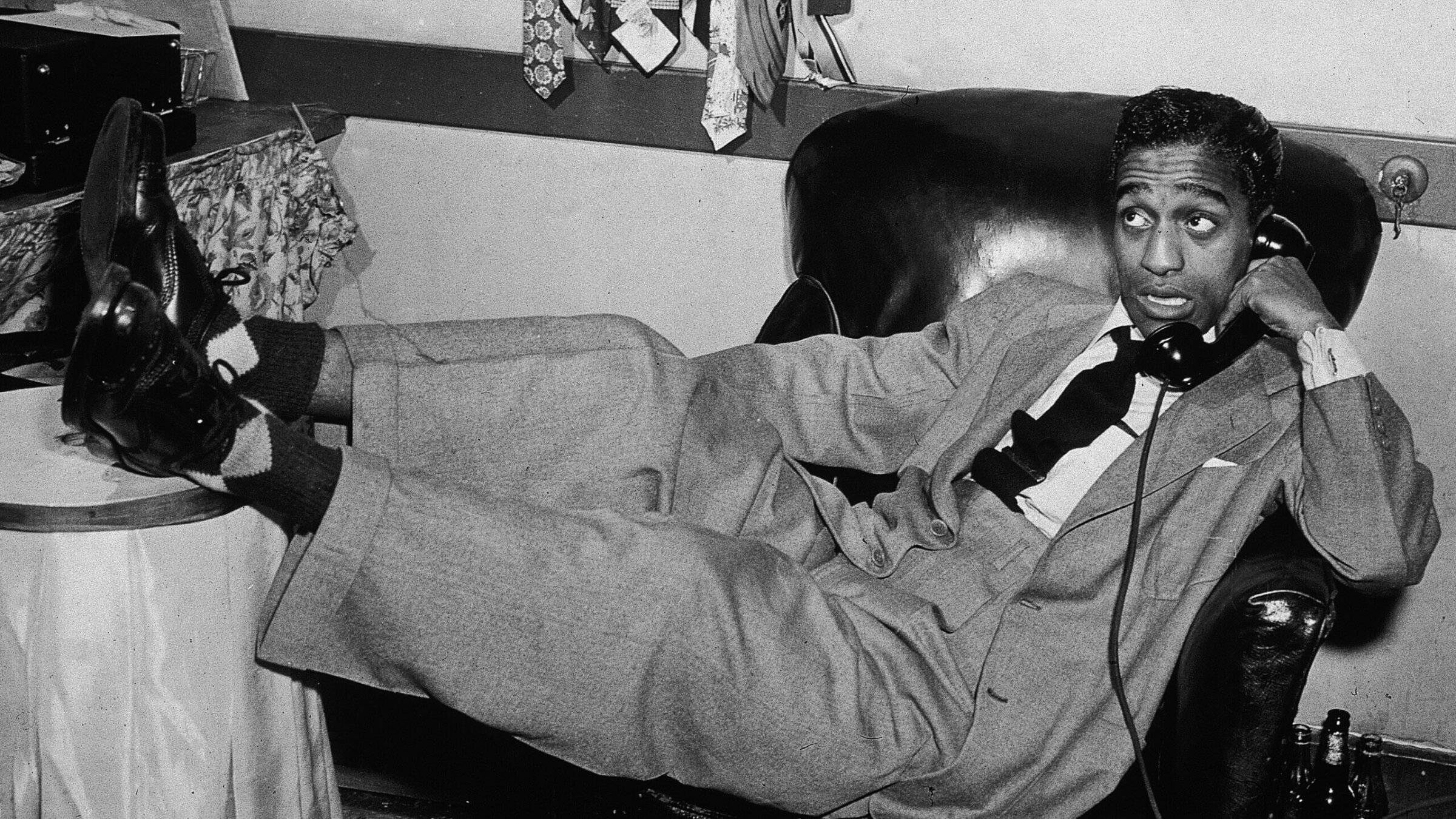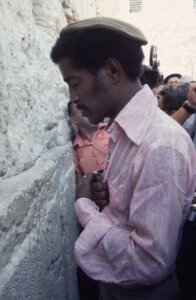The real story behind Sammy Davis Jr.’s conversion to Judaism
Jewish comedians made racist jokes about him. Some Black audiences booed him. But his faith was genuine

Sammy Davis Jr on the phone, circa 1955. Photo by Getty Images
Sammy Davis Jr. was a short and skinny Black man with one eye. His wife was white, his mother was Puerto Rican and he was a convert to Judaism. In the crass and racist world of mid-20th century comedy, he was a walking punchline, even in his own routines.
“When I move into a neighborhood, I wipe it out,” was his standard self-deprecating gag. The line received knowing laughs in the 1950s and ’60s when many towns forbade property sales to Blacks and Jews, and whites often fled when Black families moved into their neighborhoods.
Jokes by his fellow entertainers were crude. In a live skit at the Sands in Las Vegas in 1963, Dean Martin physically lifted Davis up (he weighed a mere 120 pounds) and said, “I’d like to thank the NAACP for this wonderful trophy.” At a Friars Club roast, comedian Pat Buttram said that if Davis showed up in Buttram’s home state of Alabama, folks “wouldn’t know what to burn on the lawn.”
Jewish comedians got their licks in, too. Milton Berle cross-dressed as Davis’ white wife, May Britt, and sang, to the tune of “My Yiddishe Mama,” “My Yiddish Mau-Mau,” a reference to an anti-British rebellion in Kenya.
At another roast, Joey Bishop said he’d “never been so embarrassed” in his life as when he met Davis in synagogue. When the rabbi came in, Bishop said, “Sammy jumped up and hollered, ‘Here come the judge!’”
This cringeworthy line was delivered by Davis himself in a show at the Copa: “I don’t know whether to be shiftless and lazy, or smart and stingy.”
Some of these jokes implied that it was preposterous for a Black man to convert to Judaism. But for Sammy Davis Jr., being Jewish “was the most logical thing in the world,” historian Rebecca L. Davis told me. “Over and over again, he made this analogy between being Jewish and African American. He was very admiring of the Jewish millennia-long struggle against oppressors and overcoming all kinds of obstacles.” He saw himself as “an outsider and very marginalized, and he could see in the Jewish experience a similarity that really drew him in emotionally.”
Davis, a history professor at the University of Delaware (and no relation to Sammy), has done extensive research on the entertainer’s conversion, his career and how he was perceived. Her article, “‘These Are a Swinging Bunch of People’: Sammy Davis, Jr., Religious Conversion, and the Color of Jewish Ethnicity,” appeared in the American Jewish History journal in 2016, and she included a chapter about him in her 2021 book, Public Confessions: The Religious Conversions That Changed American Politics. Her take is that Davis was not only one of the most successful entertainers of the 20th century despite the many racist barriers in his way, but that his Jewish faith was utterly genuine.
The fateful accident
Davis lost his eye when he crashed his car driving home to California from Las Vegas in November 1954. One of several stories about what sparked Davis’ path to conversion originates with the aftermath of the accident. He wrote in his 1965 autobiography, Yes I Can, that his friends Tony Curtis, who was Jewish, and Janet Leigh, who was not, arrived at the hospital and Leigh gave him a religious medal with St. Christopher on one side and a Star of David on the other. “Hold tight and pray and everything will be all right,” Leigh told him.
Davis later told Alex Haley in a Playboy interview that he gripped the object so tightly that the Star of David left a scar on his hand, “like a stigmata.” He took it as a sign that he should convert.
Davis also felt that he owed his career to a Jewish man, Eddie Cantor, who ironically had been one of vaudeville’s best-known blackface performers; Cantor’s act earned him a spot with the Ziegfeld Follies. Decades later, Cantor gave Davis his first big break, a solo televised appearance on the Colgate Comedy Hour in 1952, and became a father figure to him. “He saw Cantor’s Jewishness as part of what made Cantor a good person,” said Rebecca Davis.
In another version of how his car accident led to his conversion, Sammy Davis said that a mezuzah Cantor gave him had mistakenly been left behind in a hotel room the day of the crash. That story transformed the mezuzah “into a talisman,” Rebecca Davis observed, another signpost on the road to his conversion.
Identifying as a Jew

In his memoir, Sammy Davis recalled Rabbi Max Nussbaum, of Temple Israel in Hollywood, telling him, “We cherish converts, but we neither seek nor rush them.” But he began to publicly identify as Jewish before formally converting. In 1959 he refused to film scenes for the movie Porgy and Bess on Yom Kippur, while Ebony ran a photo of him holding Everyman’s Talmud.
He also repeatedly compared the oppression of Jews to that of African Americans. In his 1989 book, Why Me?, he wrote that he was “attracted by the affinity between the Jew and the Negro. The Jews had been oppressed for three thousand years instead of three hundred but the rest was very much the same.” When he visited the Wailing Wall in 1969, he said Israel was his “religious home.”
The reception from Black audiences
American Jews by and large loved him, and his reception in the Jewish press, including the Forward, was also positive, Rebecca Davis said. But it was more complicated for Black media. On the one hand, she said, he was “this exemplar of Black success, very wealthy, very famous, very successful” in an era of rampant racism.
On the other hand, there was “confusion and anger” about why — as a prominent Black activist who joined marches, raised money and was the United Negro College Fund’s largest donor — Sammy Davis so often connected the civil rights cause to Judaism. While there were a “disproportionate number of Jews who were passionate about civil rights and were willing to put their personal safety on the line to stand up for civil rights,” at the same time, Jews were part of a “broader American culture that saw African Americans as inferiors. That was the prevailing cultural norm among white people in the 1950s,” Rebecca Davis said. Other critics felt that he had converted to ingratiate himself with whites as a way to get ahead.
And when he “let himself be the joke” as part of the Rat Pack — a loose ensemble of performers that included Dean Martin, Frank Sinatra and Peter Lawford — that “really angered a lot of African Americans who saw him more as performing for white audiences than for Black audiences.”
He formally converted with Britt shortly before their wedding in 1960. She was as serious about it as he was, making sure, even after they were divorced, that their children went to Hebrew school and that their son was bar mitzvahed.
Disinvited from JFK’s inauguration
But their marriage also resulted in one of the most painful episodes of his life, when he was disinvited from John F. Kennedy’s presidential inauguration. The Democratic coalition that elected JFK included Southern white Democrats, and they did not want a Black man married to a white woman performing at the celebration. “They forced Davis out,” Rebecca Davis said. “He was so stung by that. Here he was on stage and on film with Dean Martin and Frank Sinatra and the biggest stars of the day, and they all got to go to the inauguration, but he didn’t.”

That rejection helps explain Davis’ subsequent embrace of Richard Nixon. “Nixon, who was politically very devious, figured he could use Sammy Davis as a token African American supporter by overdoing it and inviting him to sleep in the Lincoln bedroom,” Rebecca Davis said. That made him the first Black man to spend the night as a guest in the White House.
Some African Americans saw Davis’ alignment with Nixon and the Republicans as a betrayal. Harry Belafonte and Sidney Poitier stopped returning his phone calls, Rebecca Davis wrote, and a year or two after he performed at the 1972 Republican National Convention, he was booed at an event organized by Jesse Jackson.
He responded to the boos by saying, “I get it. I understand. But I need you to know, I always did it my way. It’s the only way I’ve got,” Rebecca Davis said. “Then he sang ‘I’ve Gotta Be Me,’ and they gave him a standing ovation.”
A steadfast Jew until the end
His third wife, Altovise, was a churchgoer, but Sammy Davis remained a steadfast Jew until the day he died. Everything he said about Judaism “was said with the utmost sincerity,” Rebecca Davis said. “He never once looked back and said, ‘Oh, that was just a phase I was going through.’ And he never talked about it in terms of his career. He only talked about it as something that spoke to him on a deep level.”
Davis died of throat cancer in 1990 at age 64. Sinatra, Berle, Liza Minnelli, Stevie Wonder, Dionne Warwick and many other celebrities were among thousands of mourners who backed up traffic for 8 miles en route to the funeral at Forest Lawn Memorial Park in LA. Rabbi Allen Freehling presided at the service, but the eulogy was given by Jesse Jackson.
“To love Sammy was to love Black and white, Black and Jew,” he said, “and to embrace the human family.”
The service also included one last standing ovation for Davis, when they played a recording of – what else? – “I’ve Gotta Be Me.”
























